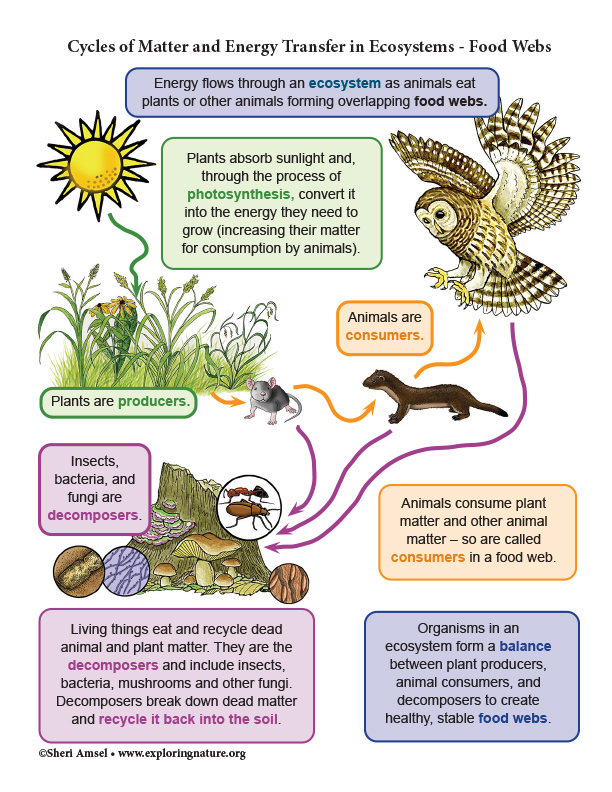

Energy flows through an ecosystem as animals eat plants or other animals forming overlapping food webs. All animals need to obtain matter for energy, growth and reproduction. Plants are at the bottom of a food pyramid, getting all their energy by changing sunlight into food through the process of photosynthesis. They get matter from CO2 from the air and nitrogen and water from the soil. This is why, in a food web, plants are called the producers - as they produce the energy on which all living things depend. Animals consume plants and other animals, so are called consumers in a food web. The living things that eat and recycle dead animals and plants are called decomposers. These include insects, bacteria, mushrooms and other fungi. The decomposers are an important part of any ecosystem because they break down dead matter and recycle it back into the soil. Soil nutrients, in turn, help plants grow, supplying the matter they need to begin the cycle over and over again. The amount of matter on Earth stays the same and is cycled over and over again.
Organisms in an ecosystem form a balance between the plant producers, animal consumers, and decomposers to create a healthy, stable food webs. The stability in an ecosystem is important so that the needs of all the organisms can be met. Organisms that are not having their needs met in an ecosystem will not survive. When a new species enters an ecosystem (e.g. invasive species), it can upset the balanced food webs and some native species can be damaged or even driven to extinction.
As organisms live their lives and eventually die, their organic matter is cycled between the air, soil, plants, animals and microbes in their environment. This cycling of matter plays an important part in the stability of an ecosystem. As organisms interact with nonliving (abiotic) parts of the environment, such as air, water, and soil, this inorganic matter cycles through the ecosystem as well.
When you research information you must cite the reference. Citing for websites is different from citing from books, magazines and periodicals. The style of citing shown here is from the MLA Style Citations (Modern Language Association).
When citing a WEBSITE the general format is as follows.
Author Last Name, First Name(s). "Title: Subtitle of Part of Web Page, if appropriate." Title: Subtitle: Section of Page if appropriate. Sponsoring/Publishing Agency, If Given. Additional significant descriptive information. Date of Electronic Publication or other Date, such as Last Updated. Day Month Year of access < URL >.
Amsel, Sheri. "Cycles of Matter and Energy Transfer in Ecosystems (6-8 Grade NGSS)" Exploring Nature Educational Resource ©2005-2025. May 22, 2025
< http://www.exploringnature.org/db/view/cycles-of-matter-and-energy-transfer-in-ecosystems-6-8-grade-ngss >

